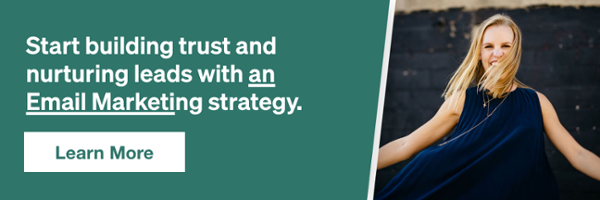Email Segmentation: 6 Best Practices

- 1. What Is Email Segmentation?
- 2. Email Marketing Segmentation Tip #1: Know The Types of Segmentation Bases
- 3. List Segmentation Tip #2: Select the Right Email Segmentation Tool
- 4. Email Segmentation Tip #3: Start Slow and Simple
- 5. List Segmentation Tip #4: Craft Emails That Target Specific Segments
- 6. Email Segmentation Tip #5: User Personalization Best Practices
- 7. Email Marketing Segmentation Tip #6: Continuously Collect Data
- 8. Optimize Your Email Marketing Efforts
“Know your audience” is one of the Golden Rules of marketing. For instance, crafting personalized emails geared for a specific reader is infinitely more effective than a generalized missive.
After all, establishing a personal connection is essential for building trust with an existing and a new subscriber.
What resonates for one reader may fall totally flat for another. If your message isn’t personalized, it’s unlikely that a recipient will open it, let alone read it and then act. In fact, the most likely outcome for any generic email is a first-class trip to the spam folder.
So, what’s the fix for this? How can you increase email opens, clicks, and conversions?
This is where email segmentation can upgrade your email marketing strategy.
What Is Email Segmentation?
Email segmentation is all about understanding consumer behavior and psychology. In simpler terms, it’s about ensuring that the right message reaches the right reader at the right time.
And how do you do that? By splitting your master contact list into smaller segments of like-minded customers with similar needs and preferences.
Using various criteria, you can break down a subscriber list of thousands of readers into various sub-lists. This empowers your team to better target those different consumers with personalized content that is more likely to land. It increases engagement since the personalized content is written for and directed to a specific group of recipients.
As Inc.com notes:1
“A business must employ market research techniques to find patterns of similarity among customer preferences in a market. Ideally, customer preferences will fall into distinct clusters based upon identifiable population characteristics. This means that if customer requirements were plotted on a graph using certain characteristics, or segmentation bases, along the axes, the points would tend to form clusters.”
There are dozens of potential benefits for email segmentation, the foremost being:
- Increased open rates
- Decreased cost of customer acquisition
- Greater email relevance
- Decreased opt-out/unsubscribe rates
- Better deliverability
- Increased sales leads
- Greater revenue
- Improved customer retention
- Lower spam responses
Email Marketing Segmentation Tip #1: Know The Types of Segmentation Bases
Knowing how to segment a market is not a straightforward task. Done right, it can improve the effectiveness of your marketing campaign and sales efforts. Done poorly, and it can result in wasted marketing dollars and lost opportunities to reach a new subscriber.
As Forbes notes,2 “If you don’t spend the time to think about your audience and gather some intelligence about their needs and challenges, you are less likely to get the outcome you want.”
Therefore, it’s helpful to break segmentation down according to categories:
- Demographics – Demographic segmentation is the most typical segmentation base since it’s fairly easy to gauge and categorize. Such factors tend to be strong indicators of consumer preferences. They include:
- Age
- Sex
- Religion
- Family size
- Education
- Socio-economic status
- Job
- Geographic Location – Where a person lives can impact the products or services they desire or the messaging they respond to. Common variables include:
- Country
- City
- State
- Population density
- Language
- Climate
- Psychology – Somewhat more difficult to measure, these may represent underlying factors that motivate consumers to make a purchase or take an action. They include:
- Brand loyalty
- Values
- Rate of product use
- Engagement levels
- Location in the sales funnel
- Personality
- Lifestyle
- Income level
- Behavioral – In behavioral segmentation, you can also break down consumers by the actions they take. This includes:
- Buyer stage
- Benefits they look for in a specific product or service
- Buyer intent
- User status
- Engagement
- Stage in the buyer’s funnel
In all likelihood, you’ll want to pull a combination of bases to tailor your segmentation toward your product. While it’s possible to go by a singular variable, a multivariable grouping will almost always be more useful and effective.
List Segmentation Tip #2: Select the Right Email Segmentation Tool
Focus groups are often viewed as a marketing relic—one that’s been replaced by Big Data.
Now, there are powerful automated tools that can help you conduct your market research, gather data, categorize it, and then analyze it. Ideally, you want a segmentation tool that gives you plenty of customizability and makes it easy to segment groups into logical bases.
Email tagging is a powerful tool that helps you organize contacts according to consumer behavior and interests. For instance, you can tag consumers by their job title, the links they click, blog articles they read, items they purchase, or by more descriptive demographics. Or, you can segment according to recent buyer actions like:
- Sign up source
- Type of customer
- Customers who purchased in the last 30 days
- Customers who haven’t purchased in the last 30 days, or even 90 days
- Cart abandonment
From there, you can further optimize segmented emails by studying how members of these groups respond to messaging. So, the next time around, you can further cull the list segmentation down to those most likely to act in a certain way or respond to a certain message.
Email Segmentation Tip #3: Start Slow and Simple
You don’t need to create dozens of multivariable segmentation lists right off the bat. In the beginning, it’s better to start simple. Your first few segmentation groups will allow you to start testing and seeing what does or doesn’t work. If you throw too many variables into the equation from the outset, it’ll be difficult to determine the underlying issue (if there is one).
Similarly, this gives you the opportunity to familiarize yourself with your automated solution. As your team becomes more comfortable with the technology and better understands how consumer subsets respond, they can then start going deeper.
List Segmentation Tip #4: Craft Emails That Target Specific Segments
Now that you’ve segmented your target audience into groups, the real work begins.
Thanks to segmentation, you have a better idea of what type of messaging will resonate and what kinds of items to send. Tips for this include:
- Using personalized and relevant email subject lines
- Employing power words
- Writing copy that is interesting and engaging
- Tailoring messaging to the segments
- Keeping messaging brief
- Including social media as a chance to share content
Whatever you do, avoid using generalized email copy that will be sent out to all of the segments. That eliminates the entire point of breaking them up. Remember, what one audience cares deeply about, another may not even bother to open. It may require more work to create several forms of a similar email, but it’s well worth the extra effort. Other tips to keep in mind when structuring your emails are email accessibility and email A/B testing.
Email Segmentation Tip #5: User Personalization Best Practices
Personalizing emails requires that you leverage the data at your disposal. You need to understand consumers’ needs and wants, and then address those with your messaging. By segmenting, it’s easier to hit commonalities that sub-segments have. But you can take this a step further:
- Look at browsing and purchasing history – When it comes to purchasing recommendations, customers prefer recommendations that are based on relevancy to them. According to Business Insider, 59.4% of adults said they’d be most likely to act on a marketing email that suggested a product that was based on their purchasing history.3
- People love deals – The same study reviewed by Business Insider stated that 64% of US consumers said they were most likely to open an email if the subject line included a promotion or a deal.33 Consumers are primed to act, so long as the proper incentives are in place.
- Embrace automation – There are a variety of automated emails you can set up for if-then scenarios. For instance, if a customer abandons a cart, then you can send an email that reminds them about it later on. Or, if you know your customer’s birthday, then you can ensure that a congratulatory email is sent out which includes a birthday special.
Email Marketing Segmentation Tip #6: Continuously Collect Data
After you’ve segmented your audience and crafted email messages that are bespoke to each group, it’s time to hit send. Only then can you start to measure the impact of your efforts.
As you do, it’s vital that you keep gathering data about prospects and customers alike. The more data you gather, the better you’ll be able to optimize segments and content.
Along those lines, every successive email campaign from here on out allows you to keep testing and optimizing. Over time, both your automated system and marketing team will gain a better understanding of who your audience is, what they respond to, and how to win them over.
Optimize Your Email Marketing Efforts
Email marketing is one of the many valuable tools in your arsenal. And segmentation helps your messaging become that much more impactful. It allows you to reach the right audience with a message that’s personalized and clearly intended for them.
But even with the help of automated programs, proper email segmentation and campaign optimization can be challenging, especially if you’re inexperienced. Sometimes, the best game plan is to outsource these tasks to the experts.
Here at Power Digital, we can provide you with a full-service email marketing strategy and implementation that segments your lists and helps you generate the most ROI possible. This includes fully stacked email campaign creation, strategic campaign development, and turnkey marketing automation.
What does that look like? Reach out to our digital marketing agency today to discover more on SMS marketing and SMS compliance.
Sources:
- Inc. Segmentation. https://www.inc.com/encyclopedia/market-segmentation.html
- Forbes. Communicating Respect: Know Your Audience. https://www.forbes.com/sites/forbescoachescouncil/2018/05/16/communicating-respect-know-your-audience/?sh=603dcdf54067
- Business Insider. Consumers look for relevancy, personal benefits, and the opportunity to take action in emails.https://www.businessinsider.com/what-matters-most-to-consumers-regarding-email-2020-11
Our Editorial Standards
Reviewed for Accuracy
Every piece is fact-checked for precision.
Up-to-Date Research
We reflect the latest trends and insights.
Credible References
Backed by trusted industry sources.
Actionable & Insight-Driven
Strategic takeaways for real results.





